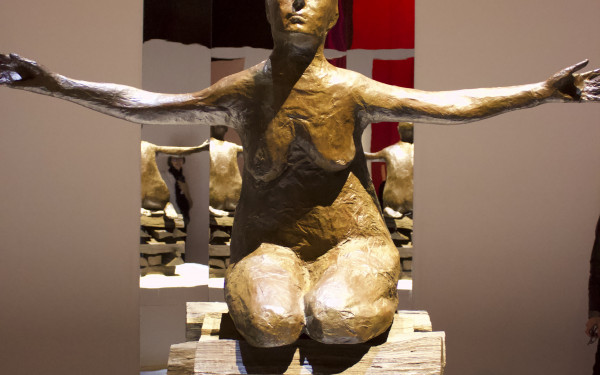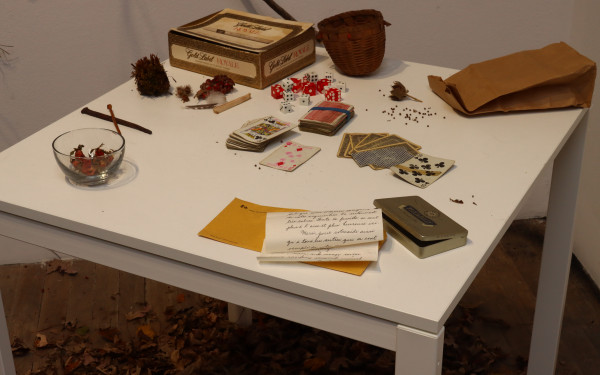Summer-Harmony Twenish’s body is the land
My Body is the Land uses dreamy, Barbie-esque colours to highlight the connection between land and body sovereignty
Indigenous women are front and centre at Summer-Harmony Twenish’s exhibit, My Body is the Land. They stare directly at the viewer, existing unapologetically on their own terms.
“When I studied art history, any art about Native people was from a non-Native perspective,” said Twenish, an Algonquin Anishinaabe artist who works primarily as a digital illustrator. “I like to take that power back in my work, and it felt like the statement ‘My Body is the Land’ articulates that. I can't be separated from my homelands. I am a part of them. They're a part of me.”
The exhibit is currently on display at Galerie Shé:kon, a gallery that focuses on showcasing solo exhibitions by up-and-coming Indigenous artists and curators. My Body is the Land is also part of the 17th edition of Festival Art Souterrain, a non-profit organization and a contemporary art festival that aims to make contemporary art accessible through exhibitions, performances and other artistic activities in Montreal’s underground city. This year, artists were given the theme “habitat.”
Twenish explained that when they heard the theme “habitat,” they began to think of the way that Indigenous people relate to the land and their environments.
“The land is something that you respect and you take care of and you nurture. What you give is what you get,” they said. “As Native people, we understand what it's like to be stripped of our autonomy and to also see the lands that we come from have their autonomy removed, or be taken away from our position as caretakers of the land.”
They explained that settler narratives often depict the land as an unfeeling object, whereas Indigenous people view who they are and the land as hand in hand. Throughout her work, Twenish uses stars and flowers to hint at this connection.
“The imagery is evocative,” said Mark Harris, a visitor at the gallery. “The colours are so alive, and the imagery is very political and beautiful.”

Twenish mixes joy, silliness and anger covered in cutesy pink. One of Twenish’s favourite pieces, called Language Teacher, features the profile of a woman with lavender hair saying “kimoodiye.”
A few years ago, Twenish tweeted, “In Algonquin, we don't say ‘I love you,’ we say kimoodiye, which means I could not dream without you. And I think that's beautiful.”
The tweet ended up going viral.
“A bunch of white ladies in my comments were like, ‘This is how I feel about my husband,’ but they don't realize it actually means shithead,” Twenish said. “So, if you Google Kimoodiye, you find a bunch of poems and posts with the word used in a completely different context. But it's just a thing we say back home when we're little kids and we want to swear at our friends.”
Twenish grew up with dress-up games and barbie.com, which inspired the vibrant blues, pinks and purples that appear in their digital paintings and animations. As a self-taught artist, they draw inspiration from the aesthetics they loved as a child mixed with elements of queerness, body positivity and fierce anti-colonial feminist thought.
“I have always loved those aesthetics, but I've also always been very angry and political and unafraid to voice my opinions on things,” Twenish said. “I like to create these dreamy landscapes with a message or a beautiful Native Barbie.”
According to Amanda Lickers, the exhibit’s curator, Twenish uses their work to say fierce, poignant and even provocative things that can be difficult for a settler audience to hear.
“Summer's work explores the land, but also the relationship with their body,” Lickers said. “In Indigenous worldviews, the land-body relationship is extremely important.”
Lickers explained that Twenish’s work connects to self-determination and autonomy. It asks what it means to be sovereign and have unceded territory, and what it means for Indigenous people to assert cultural and community belonging on their lands.
“I hope that people will reflect a little bit differently on how normalized land theft has become,” Lickers said. “And I think it's very important to see Indigenous art being represented in an industry that has a lot of catching up to do when it comes to decolonization, and have the space to be able to reclaim that.”
My Body is the Land will be on display at Galerie Shé:kon until April 19.


_600_832_s.png)



_600_375_90_s_c1.jpg)
